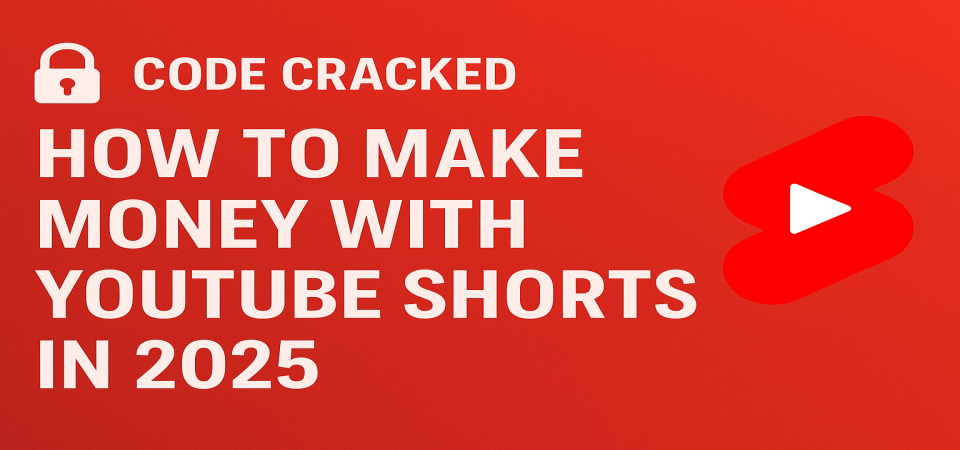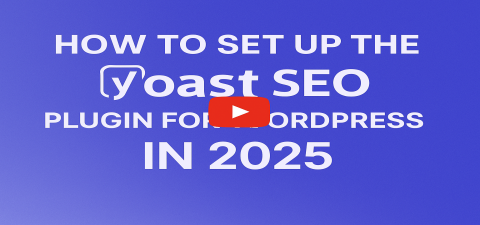
Code Cracked: How to Make Money with YouTube Shorts in 2025
YouTube Shorts has exploded onto the scene, offering creators a fast-paced and accessible way to reach a massive audience. But can you make significant money with those bite-sized videos? According to a recent in-depth analysis, the answer is a resounding yes, especially with the introduction of YouTube's innovative music program.
This post dives into the strategies and insights shared in the video, providing a roadmap for aspiring and current creators looking to monetise their YouTube Shorts in 2025.
Why Diving into YouTube Shorts -Things You Should Know
Before we delve into the earning potential, let's weigh the advantages and disadvantages of focusing on YouTube Shorts:
The Upsides:
Ease of Creation: Shorts are generally quicker and simpler to produce compared to long-form videos.
Lower Production Costs: You don't need expensive equipment or extensive filming locations to create engaging Shorts. Many can even be made entirely on your smartphone.
Lower Skill Barrier: Basic editing and creative ideas can go a long way in the world of Shorts.
Rapid Channel Growth: With compelling content, Shorts channels can experience significant growth in subscribers and views within a short timeframe (1-2 months).
The Challenges:
High Competition: The popularity of Shorts means there's a lot of content vying for viewers' attention.
The Rise of AI Content: Many channels are leveraging AI for voice cloning and content generation, increasing the competition across various niches.
Unlocking the Earning Potential: RPM, CPM, and the YouTube Music Program
The video provides some insight into the key metrics necessary to comprehend YouTube Shorts ' earnings:
This is the estimated revenue you make per 1,000 views, according to RPM ( Revenue Per Mille). For Shorts, the RPM tyρically ranges from $0.05 to $ 0.30. This means that you could make $50 to $300 for every million views you receive.
CPM ( Cost Per Mille): How much do advertisers pay for 1,000 ad impressions in CPM? A higher CPM typically coɾresponds to a higher RPM, even though it is not directly related to your earnings.
The YouTube Music Program is the game-changer that is highlighted in the video. This initiative, which was just introduced, enables creators to incorporate a particular genre σf music into their short films αnd substantially increase their income. Createurs can increase their CPM by an estimated $ 0.10 to $ 0.70, potentially increasing the overall average CPM to about $ 0.50, by using eligible music.
Real-World Impact:
The video features a case study of a Shorts channel called "Slam Dunk," which consistently pulls in over 100 million views monthly. Without the music program, their earnings would be in the lower five-figure range. However, with the potential CPM increase from the music program, their monthly earnings could skyrocket to around $50,000.
Another compelling success story shared is that of "Loyal," a creator who started focusing on Shorts nine months prior and has already earned over $124,000 through YouTube and music revenue, with his best month hitting $50,000 in pure profit.
How to be Eligible for the YouTube Music Program:
To qualify for this lucrative program, your Shorts channel needs to achieve over 1 million views in the last 30 days.
Step-by-Step Guide to Creating a Profitable Shorts Channel in 2025
The video outlines a practical four-step process to build a successful and monetizable YouTube Shorts channel:
Step 1: Find Your Niche – What Kind of Shorts Will You Create?
Method 1: Copy What Works (with a Twist): Analyse popular content within YouTube Shorts. Identify successful video formats and topics, and then put your unique spin on them. Aim for a 5-10% difference to stand out while leveraging proven engagement. The example of "Sins," which reportedly earned $180,000 in a year by adapting successful video formats, illustrates this strategy.
Method 2: Leverage Analytics Tools: Utilise platforms like "Viewstats by Mr. Beast" to discover trending channels and top-performing content within specific niches every month. This allows you to identify underserved areas or consistently engaging themes. The case of "Dinino," who gained 600,000 subscribers in five months by replicating successful content, showcases the power of this approach.
Method 3: Doom Scrolling with Purpose: Turn your casual browsing into market research. Actively engage with content you enjoy and want to create, training your "For You" page. Pay close attention to the elements that make these videos engaging and take notes for your own creations.
Step 2: Create a Detailed Checklist for Your Chosen Niche
Once you've identified your niche, analyse the top-performing channels within it. Create a comprehensive checklist of every recurring element you observe in their Shorts, regardless of your personal preferences. This might include:
Eye-catching opening clips
Fast-paced editing
Use of specific sound effects or music
Clear and concise messaging
Strong hooks and calls to action
Specific visual styles or on-screen text
The "Slam Dunk" channel example highlighted elements like engaging first clips, high-quality visuals, and compelling hooks. This checklist serves as your blueprint for creating engaging content.
Step 3: Mastering the Art of Making the Video
Creating high-quality Shorts requires developing a range of skills:
Research: Understanding your niche and finding engaging topics.
Scriptwriting: Crafting concise and attention-grabbing scripts, even for short videos.
Voiceovers: Delivering clear and engaging narration (or utilising AI tools).
Editing: Mastering the art of fast-paced and visually appealing editing.
Initially, the video recommends editing your videos to build a strong foundation. As your channel grows, you can consider hiring freelance editors (platforms like Twitter or job boards specialising in video editing can be useful) or collaborating with friends.
The video provides a practical example of scripting a Short based on "Kai Cenat's First Subscriber," demonstrating how to create an initial hook, re-engage viewers, and craft a compelling conclusion within a short timeframe. Aim to streamline your process; with practice, scripting, and voiceovers can take as little as 15-30 minutes.
Common Questions Addressed:
Posting Frequency: Start with one high-quality Short per day. Increase frequency only after gaining some traction and understanding what resonates with your audience.
Editing Software: Premiere Pro is suggested as a robust option.
Background Music: Explore platforms like Epidemic Sounds or the YouTube Audio Library. The "Slam Dunk" channel uses "East Hills instrumental."
"View Jail": The idea of being permanently stuck with low views is dismissed. Focus on consistently improving your content based on analytics.
Voiceovers: If you struggle with voiceovers, consider using AI voice generation tools like 11 Labs.
Small Details Matter: Even in short videos, meticulous revisions are crucial to prevent viewers from swiping away.
Step 4: Deep Dive into Your Analytics
Understanding your YouTube Shorts analytics is paramount for continuous improvement. Focus on these key metrics:
Swipe Rate: The percentage of viewers who swipe away from your video within the first four seconds. Aim for a swipe rate below 20%. This highlights the effectiveness of your initial hook.
Average Percentage Viewed: The average portion of your video that viewers watch. High retention is key (aim for high percentages, sometimes as high as 98% in certain niches).
Retention Graph: This visual representation shows viewer drop-off points. A relatively flat graph indicates good engagement. Significant dips reveal areas in your video that need improvement.
The entire process is iterative: post -> analyse -> improve -> repeat.
Don't be discouraged if your initial videos get few views. Consistency and a commitment to improvement will eventually lead to viral potential. The video even touches on the "zoink and twist" method – attempting to replicate and slightly modify a previously successful Short to try and surpass its performance.
Expanding on YouTube Money Calculators: Estimating Your Shorts Earnings
While the video provides valuable insights into RPM and CPM, many creators look for tools to help them estimate their potential earnings. YouTube money calculators can offer a rough estimate based on certain assumptions. Here's how to use them effectively and understand their limitations:
How YouTube Money Calculators Work (Generally):
Most YouTube money calculators ask for the following inputs:
Estimated Monthly Views: This is the number of views you anticipate your Shorts (or long-form videos, depending on the calculator) will receive in a month.
Estimated Engagement Rate (Optional): Some calculators might ask for an engagement rate (likes, comments, shares as a percentage of views). While engagement is crucial for growth, it doesn't directly translate to ad revenue on Shorts in the same way as long-form content.
Estimated CPM/RPM: Some advanced calculators might allow you to input an estimated CPM or RPM. This is where the insights from the video ($0.05 - $0.30 typical RPM, potential increase with the Music Program) become valuable.
Steps to Use a YouTube Money Calculator:
Use our Reputable Calculator: Search for "YouTube money calculator"
Estimate Your Monthly Views: This is the trickiest part. If you're just starting, you'll need to make an educated guess based on your content's potential reach and your posting frequency. If you have existing Shorts, look at your past performance to project future views. Remember that Shorts can have highly variable view counts.
Input Your Estimated Views: Enter this number into the calculator.
Enter Your Estimated RPM (Crucial for Shorts): This is where your understanding of Shorts monetisation comes in. Instead of the often higher CPM/RPM values for long-form content that these calculators might default to, enter a range based on the video's information:
Without the Music Program: Use a range of $0.05 to $0.30.
Potentially with the Music Program (if you qualify and use eligible music): You might estimate a higher end, perhaps up to $0.50 or slightly more, based on the video's analysis. Be realistic.
View Estimated Earnings: The calculator provides a range of potential monthly and annual earnings.
Important Limitations of YouTube Money Calculators:
They are Estimates: These tools provide rough estimations and are not guarantees of income. Actual earnings can vary significantly.
Fluctuating RPM/CPM: RPM and CPM rates change based on various factors, including advertiser demand, seasonality, audience demographics, and ad formats.
Not Specific to Shorts (Often): Many calculators are primarily designed for long-form content and may not accurately reflect the lower RPMs typically seen with Shorts (unless you specifically adjust the RPM input).
Ignores the Music Program's Nuances: Most generic calculators won't have specific inputs for the YouTube Music Program's impact on earnings.
Doesn't Account for Channel Growth: Your view counts, and therefore, potential earnings will hopefully increase over time as your channel grows. Calculators provide a snapshot based on a specific view count.
Other Monetisation Methods: Calculators usually focus solely on ad revenue. They don't factor in other potential income streams, such as brand sponsorships, merchandise, or channel memberships.
Using Calculators Wisely:
YouTube money calculators can help get a general idea of potential earnings based on different view count scenarios and RPMs. However, it's crucial to:
Use realistic RPM figures for Shorts.
Understand the limitations of these tools.
Focus on creating high-quality, engaging content that attracts a large audience.
Continuously analyse your actual YouTube analytics for the most accurate picture of your earnings.
Making money with YouTube Shorts in 2025 is a tangible goal, especially with the added revenue potential of the YouTube Music Program.
By understanding the dynamics of Shorts monetisation, following a strategic approach to content creation, and continuously analysing your performance, you can position yourself for success in this exciting and rapidly evolving landscape.
The information shared in the video provides a solid foundation; now it's up to you to take action and start creating!





